Each neighborhood of Seattle proudly waves the banner of its unique name, and yet many were named in a similar way: by real estate investors. Fremont in Seattle was also named by real estate investors. What made the Seattle neighborhood called Fremont stand out from others, was its good location, its jump-start after Seattle’s Great Fire of 1889, and its vigorous developers who utilized the growing streetcar system to advantage.
In 1840 American author James Fenimore Cooper wrote a novel called Pathfinder about a wilderness scout who guided setters to the frontiers of the USA. Although the main character was fictional, his exploits fired the imaginations of Americans who had been bitten by the romance of westward exploration.
A few years later, the nickname “Pathfinder” attached itself to a real person, John Charles Fremont. Fremont was commissioned by the US government to explore western routes, retracing some of the 1804 travels of Lewis & Clark but also searching out new information about rivers, mountains, and suitability of lands for American settlement.
Beginning in 1843, John Charles Fremont the Pathfinder made ten journeys of exploration. Fremont’s journals, first published by the US Congress, became wildly popular. The records of Fremont’s explorations were excerpted in newspapers and reprinted by private publishers for sales.
“Fremont’s maps and his descriptions set off one of the most important migrations of U.S. history…. tens of thousands began to think of crossing the continent to Oregon and California… In 1845 three thousand Americans would make the trek to Oregon, doubling the white population there.” (quotes from page 321 of Lions of the West: Heroes and Villains of the Westward Expansion, by Robert Morgan, 2011.)
It has been estimated that there may be one hundred or more places in the American West which have been named for John Charles Fremont, from mountain peaks and rivers to counties and towns. One such place is Fremont, Nebraska. Fremont is between the Platte and Elkhorn Rivers, a flat area which John Charles Fremont surveyed and recommended for the route of a railroad, and that led to establishment of the town in 1856.
From Fremont in Nebraska to Fremont in Seattle
In 1888 Edward and Carrie Blewett from Fremont, Nebraska, came to Seattle to make a land investment. Their contact in Seattle was Luther H. Griffith, also from Fremont, Nebraska, who had moved to Seattle in 1883 and was favorably impressed as he saw the growth of the city.
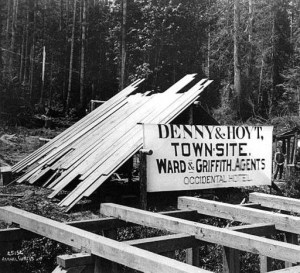
Seattle photographer Asahel Curtis (brother of Edward Curtis) took this photo of the real estate sign at the new suburb of Fremont in 1888. Photo courtesy of UW Special Collections, Asahel Curtis #482.
In 1888 Luther Griffith learned that a large tract of vacant land might become available for development, and he communicated this to the Blewetts. The Seattle banking and investment partnership of Arthur Denny and John P. Hoyt had already bought the land, but after only a few months they re-sold it at a profit to the Blewetts.
The Blewetts kept the plat name which had been assigned, “Denny & Hoyt’s Addition to Seattle” but since the land was outside of the city limits they named it as a separate town, Fremont. The Nebraska investors saw the advantages of Fremont as a Seattle residential suburb and as a future industrial site on Lake Union.
The Blewetts did not stay long, as they intended to be investors but not on-site developers of their property. On their behalf, in the summer of 1888 Luther Griffith, the Blewett’s representative in Seattle, began to advertise and sell lots in the new Fremont.
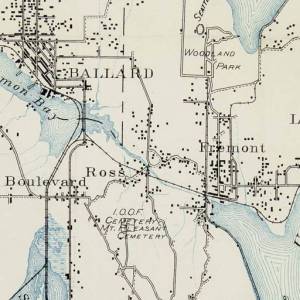
In 1894 Ross and Fremont were shown as place names with railroad stops. The ship canal had not yet been built but there was a creek called The Outlet from Lake Union, flowing westward. McKees Correct Road Map of 1894, courtesy of Seattle Public Library Special Collections.
The new suburb of Fremont was located at the northwest corner of Lake Union, where a stream called The Outlet flowed westward toward Ballard. As early as 1854, Seattle settlers had visualized that this small creek could be enlarged to create a canal for sending logs out to Puget Sound, and for other industrial uses such as sending shipments of coal by boat. That was the reason why the name “Lake Union” was proposed at Seattle’s first Fourth of July picnic in 1854. The Seattle settlers saw that connections could be dug to unite the lake with Puget Sound for shipping.
Beginning in the 1850s all of Seattle’s earliest-developing settler communities had been located on waterfronts for ease of travel and for convenience of transporting goods via water, most especially heavy timbers and loads of coal. Fremont’s excellent location on one side of Lake Union had been chosen by its first homestead claimant, William A. Strickler. After Strickler disappeared in 1861, his land claim was preserved due to long-running legal problems, so that as of 1888 the (future) Fremont area still had not been developed.
Fremont is born in a boom
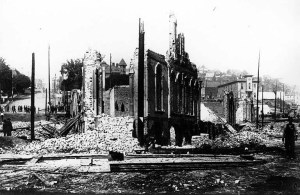
Seattle’s Great Fire of June 6, 1889, caused a growth spurt of rebuilding and caused development to be pushed outward from downtown.
The timing of the Fremont investment could not have been better. One year after the establishment of Fremont in 1888, Seattle’s Great Fire of June 6, 1889 caused city growth and development to be pushed outward from downtown. Across the USA, people heard of the Seattle Fire and knew that a construction boom would follow as the city rebuilt itself. An average of 2,000 people per month began arriving in Seattle, looking for jobs and for opportunities to grow with the rebuilding of the city. In one year’s time the population of Seattle jumped from 25,000 to 43,000 people.
To get an idea of the economic boom caused by the Seattle Fire, we can look at statistics for plat filings. It had taken 34 years (1853 to 1887) for developers to create 168 subdivisions in all of King County, with most filed in the vicinity of Seattle. In just three years from 1889 to 1891, more than 400 new subdivisions were filed. (Statistics from page 12, Early Neighborhood Historic Resources Survey Report, see source list.)
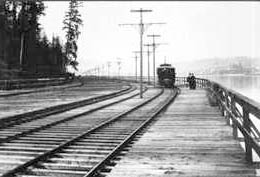
Looking north along Westlake Avenue toward Fremont circa 1895. Photo courtesy of UW Special Collections, Lake Union Improvement Company photos.
Fremont attracted residents and businesses in growth industries such as a lumber mill, an iron foundry, a tannery and a construction materials supply business. Investors and promoters of Fremont Luther H. Griffith and Edward C. Kilbourne named the streets in Fremont. These men were also involved in creation of a streetcar line which would carry potential buyers out via Westlake Avenue to the new development.
From Fremont another streetcar route ran to Guy Phinney’s private zoo (now Woodland Park.) Next, in the 1890s Luther Griffith and Edward C. Kilbourne went into partnership with real estate developer William D. Wood to construct a streetcar line from Fremont to Green Lake.
By 1900 the Stone & Webster cartel had taken over ownership of streetcar lines in Seattle. As of 1910, Stone & Webster completed a railroad called the Interurban which also ran through Fremont. The transfer point is commemorated today by the Waiting for the Interurban statue at the corner of North 34th Street & Fremont Avenue N. The Interurban train continued on through Seattle to the city of Everett about forty miles to the north.
The success of early developers and boosters in making Fremont a transit hub/transfer point, eventually led to the description of Fremont as the Center of the Universe.
Sources:
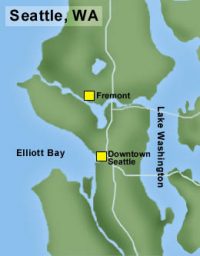
Fremont was a successful early community because of its advantageous location at one corner of Lake Union. Map courtesy of HistoryLink.
Context Statement, Historic Resources Survey Report, Fremont, January 2010. Context statement written by Caroline Tobin; architectural survey report written by Katheryn H. Krafft. Historic Preservation Program, Department of Neighborhoods, Seattle.
Early Neighborhood Historic Resources Survey Report and Context Statement by Greg Lange and Thomas Veith, 2005 (revised 2009.) The report is listed as “Residential structures constructed prior to 1906” under context statements, Seattle Department of Neighborhoods historic preservation page.
“Edward Corliss Kilbourne,” HistoryLink Essay #1251 by Louis Fiset, 1999.
“Interurban Rail Transit in King County and the Puget Sound Region,” HistoryLink Essay #2667 by Walt Crowley, 2000.
Lions of the West: Heroes and Villains of the Westward Expansion, by Robert Morgan, 2011. Seattle Public Library 978.02. Chapter eight: Kit Carson: Taking Boone’s Trace to the Pacific, pages 306-350. In the years 1842-1846 Kit Carson, famous mountain man, was the guide for Fremont’s three expeditions of exploration of the West.
Pathfinder: John Charles Fremont and the Course of American Empire, by Tom Chaffin, 2002. Seattle Public Library, biography section.
“Seattle’s Great Fire,” HistoryLink Essay #715 by Greg Lange, 1999. See also Essay #10743.
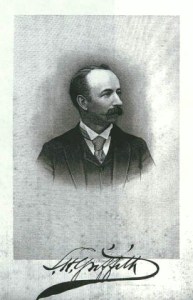
Luther H. Griffith portrait circa 1891. Griffith was a real estate salesman and was involved in the extension of streetcar lines. Photo courtesy of UW Special Collections PH 33.6
“Seattle Neighborhoods: Fremont Thumbnail History,” HistoryLink Essay #1320 by Patrick McRoberts, 1999.
“Seattle Neighborhoods: Phinney Thumbnail History,” HistoryLink Essay #3526 by Louis Fiset, 2001.
“Seattle residents celebrate Independence Day on July 4, 1954, and adopt names for Lake Union and Lake Washington,” HistoryLink Essay #1445 by Walt Crowley, 1999.
“Street Railways in Seattle,” HistoryLink Essay #2707 by Walt Crowley, 2000.
Title abstract, Fremont land chain of ownership, by Greg Lange, 2007, unpublished document.
University of Washington Special Collections, Lake Union Improvement Company photo album of 1891.
“William D. Wood,” HistoryLink Essay #1169 by Louis Fiset, 1999.
“Woodland Park Zoo,” HistoryLink Essay #1481 by Walt Crowley, 1999.

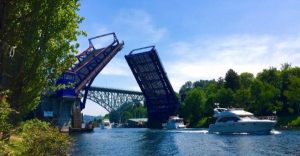
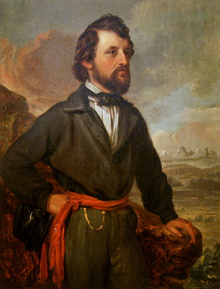
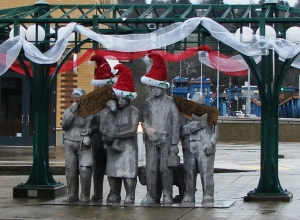
Love posts like this! I always learn something!
Pingback: W Blewett Way ~ Writes of Way